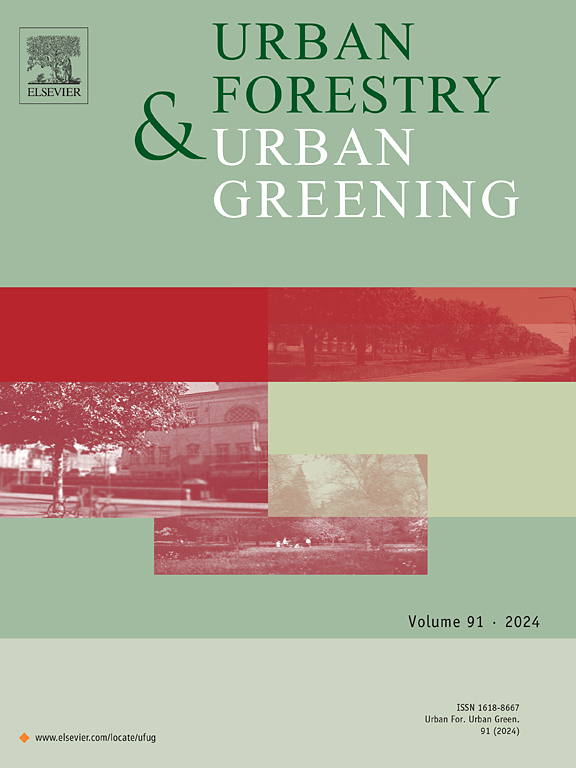越绿就越健康吗?研究中国武汉城市绿地与心理健康之间的非线性关系
IF 6
2区 环境科学与生态学
Q1 ENVIRONMENTAL STUDIES
引用次数: 0
摘要
尽管许多证据表明城市绿地(UGS)有益于心理健康,但人们仍然无法确定更绿色的生活环境是否一定会带来更好的心理健康。本研究弥补了这一空白,探讨了城市绿地(UGS)的提供(可用性、可达性、能见度、质量)和利用(频率、持续时间)对心理健康的潜在非线性影响,重点关注其非线性模式和阈值。利用中国武汉的地理空间和社会调查数据,并控制社会经济、建筑和社会环境因素,我们发现(1) UGS 的提供和使用对心理健康都有显著的非线性影响。(2)心理健康与 UGS 可用性(以归一化差异植被指数衡量)和可达性(与最近公园的距离)之间存在倒 "U "型关系,在归一化差异植被指数为 0.25 或距离为 0.24 千米时观察到最高效益。在城市地质公园的能见度方面也观察到类似的 L 型关系,这表明较高的能见度并不一定会改善心理健康。城市地质服务质量对健康的积极影响是存在的,但带来的益处微乎其微。(3) 地下管线系统的利用率起着关键的中介作用,在能见度与心理健康之间的关系中占 47%。这凸显了积极参与城市综合体对实现心理健康益处的重要性,支持了 "环境提供→个人行为→心理健康 "的路径。这些发现为城市规划者分配城市综合服务设施提供了有价值的剂量参考,强调了在城市环境中,既要考虑提供,也要考虑促进利用的因素,以实现心理健康效益的最大化。本文章由计算机程序翻译,如有差异,请以英文原文为准。
Is greener always healthier? Examining the nonlinear relationships between urban green spaces and mental health in Wuhan, China
Though much evidence demonstrates the benefits of urban green spaces (UGS) for mental health, it remains uncertain if a greener living environment necessarily leads to better mental health. This study makes up this gap by exploring the potential non-linear effects of UGS provision (availability, accessibility, visibility, quality) and utilization (frequency, duration) on mental health, focusing on their nonlinear patterns and thresholds. Using geospatial and social survey data from Wuhan, China, and controlling for socioeconomic, built, and social environmental factors, we find that: (1) Both UGS provision and utilization have significant nonlinear effects on mental health. (2) Inverted-U-shaped relationships exist between mental health and both UGS availability (measured by Normalized Difference Vegetation Index, NDVI) and accessibility (distance to nearest park), with peak benefits observed at an NDVI of 0.25 or a distance of 0.24 km. A similar L-shaped relationship is observed for UGS visibility, suggesting that higher visibility does not necessarily translate to improved mental health. The positive health effects of UGS quality exist, yet offer marginal benefits. (3) UGS utilization plays a crucial mediating role, explaining up to 47 % of the relationship between visibility and mental health. This highlights the importance of active engagement with UGS for realizing mental health benefits, supporting the ‘environmental provision→individual behavior→mental health’ pathway. These findings provide urban planners with valuable dosage references for UGS allocation, emphasizing the need to consider both provision and factors promoting utilization to maximize mental health benefits within urban environments.
求助全文
通过发布文献求助,成功后即可免费获取论文全文。
去求助
来源期刊

Urban Forestry & Urban Greening
FORESTRY-
CiteScore
11.70
自引率
12.50%
发文量
289
审稿时长
70 days
期刊介绍:
Urban Forestry and Urban Greening is a refereed, international journal aimed at presenting high-quality research with urban and peri-urban woody and non-woody vegetation and its use, planning, design, establishment and management as its main topics. Urban Forestry and Urban Greening concentrates on all tree-dominated (as joint together in the urban forest) as well as other green resources in and around urban areas, such as woodlands, public and private urban parks and gardens, urban nature areas, street tree and square plantations, botanical gardens and cemeteries.
The journal welcomes basic and applied research papers, as well as review papers and short communications. Contributions should focus on one or more of the following aspects:
-Form and functions of urban forests and other vegetation, including aspects of urban ecology.
-Policy-making, planning and design related to urban forests and other vegetation.
-Selection and establishment of tree resources and other vegetation for urban environments.
-Management of urban forests and other vegetation.
Original contributions of a high academic standard are invited from a wide range of disciplines and fields, including forestry, biology, horticulture, arboriculture, landscape ecology, pathology, soil science, hydrology, landscape architecture, landscape planning, urban planning and design, economics, sociology, environmental psychology, public health, and education.
 求助内容:
求助内容: 应助结果提醒方式:
应助结果提醒方式:


